belt GMC YUKON DENALI 2004 Owners Manual
[x] Cancel search | Manufacturer: GMC, Model Year: 2004, Model line: YUKON DENALI, Model: GMC YUKON DENALI 2004Pages: 468, PDF Size: 3.18 MB
Page 1 of 468
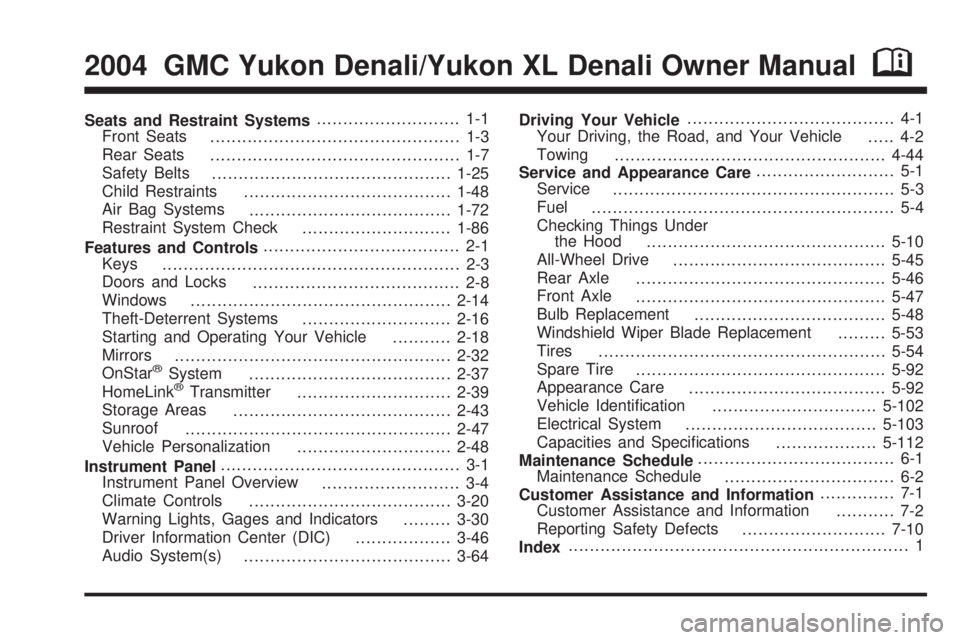
Seats and Restraint Systems........................... 1-1
Front Seats
............................................... 1-3
Rear Seats
............................................... 1-7
Safety Belts
.............................................1-25
Child Restraints
.......................................1-48
Air Bag Systems
......................................1-72
Restraint System Check
............................1-86
Features and Controls..................................... 2-1
Keys
........................................................ 2-3
Doors and Locks
....................................... 2-8
Windows
.................................................2-14
Theft-Deterrent Systems
............................2-16
Starting and Operating Your Vehicle
...........2-18
Mirrors
....................................................2-32
OnStar
žSystem
......................................2-37
HomeLinkžTransmitter
.............................2-39
Storage Areas
.........................................2-43
Sunroof
..................................................2-47
Vehicle Personalization
.............................2-48
Instrument Panel............................................. 3-1
Instrument Panel Overview
.......................... 3-4
Climate Controls
......................................3-20
Warning Lights, Gages and Indicators
.........3-30
Driver Information Center (DIC)
..................3-46
Audio System(s)
.......................................3-64Driving Your Vehicle....................................... 4-1
Your Driving, the Road, and Your Vehicle
..... 4-2
Towing
...................................................4-44
Service and Appearance Care.......................... 5-1
Service
..................................................... 5-3
Fuel
......................................................... 5-4
Checking Things Under
the Hood
.............................................5-10
All-Wheel Drive
........................................5-45
Rear Axle
...............................................5-46
Front Axle
...............................................5-47
Bulb Replacement
....................................5-48
Windshield Wiper Blade Replacement
.........5-53
Tires
......................................................5-54
Spare Tire
...............................................5-92
Appearance Care
.....................................5-92
Vehicle Identi®cation
...............................5-102
Electrical System
....................................5-103
Capacities and Speci®cations
...................5-112
Maintenance Schedule..................................... 6-1
Maintenance Schedule
................................ 6-2
Customer Assistance and Information.............. 7-1
Customer Assistance and Information
........... 7-2
Reporting Safety Defects
...........................7-10
Index................................................................ 1
2004 GMC Yukon Denali/Yukon XL Denali Owner ManualM
Page 7 of 468
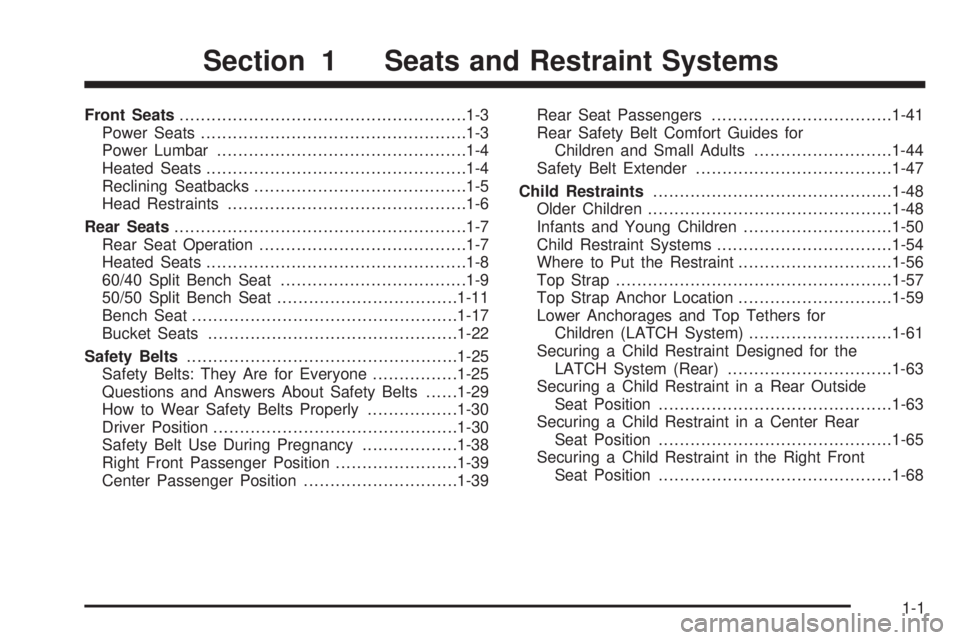
Front Seats......................................................1-3
Power Seats..................................................1-3
Power Lumbar...............................................1-4
Heated Seats.................................................1-4
Reclining Seatbacks........................................1-5
Head Restraints.............................................1-6
Rear Seats.......................................................1-7
Rear Seat Operation.......................................1-7
Heated Seats.................................................1-8
60/40 Split Bench Seat...................................1-9
50/50 Split Bench Seat..................................1-11
Bench Seat..................................................1-17
Bucket Seats...............................................1-22
Safety Belts...................................................1-25
Safety Belts: They Are for Everyone................1-25
Questions and Answers About Safety Belts......1-29
How to Wear Safety Belts Properly.................1-30
Driver Position..............................................1-30
Safety Belt Use During Pregnancy..................1-38
Right Front Passenger Position.......................1-39
Center Passenger Position.............................1-39Rear Seat Passengers..................................1-41
Rear Safety Belt Comfort Guides for
Children and Small Adults..........................1-44
Safety Belt Extender.....................................1-47
Child Restraints.............................................1-48
Older Children..............................................1-48
Infants and Young Children............................1-50
Child Restraint Systems.................................1-54
Where to Put the Restraint.............................1-56
Top Strap....................................................1-57
Top Strap Anchor Location.............................1-59
Lower Anchorages and Top Tethers for
Children (LATCH System)...........................1-61
Securing a Child Restraint Designed for the
LATCH System (Rear)...............................1-63
Securing a Child Restraint in a Rear Outside
Seat Position............................................1-63
Securing a Child Restraint in a Center Rear
Seat Position............................................1-65
Securing a Child Restraint in the Right Front
Seat Position............................................1-68
Section 1 Seats and Restraint Systems
1-1
Page 11 of 468
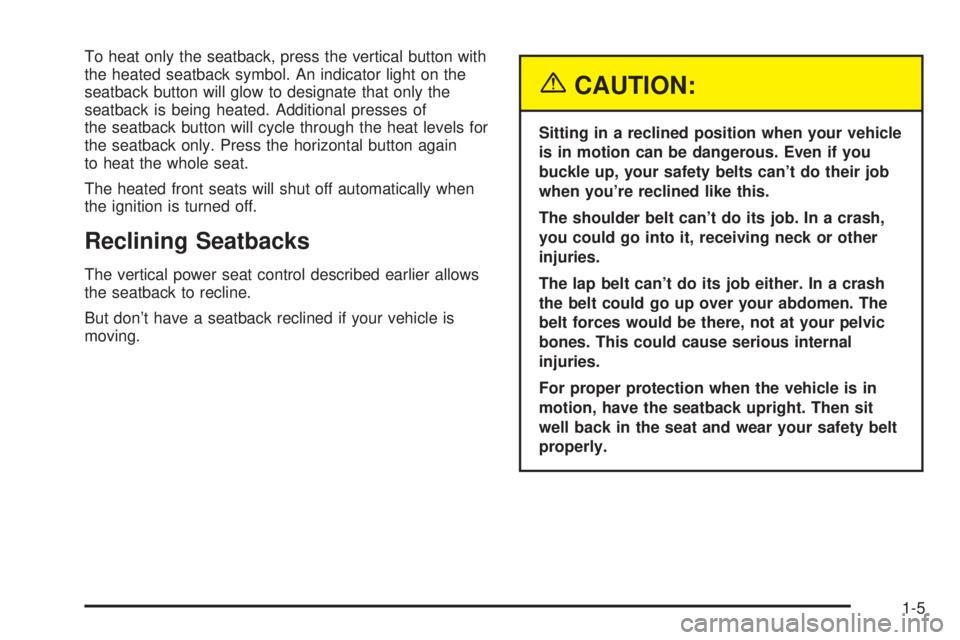
To heat only the seatback, press the vertical button with
the heated seatback symbol. An indicator light on the
seatback button will glow to designate that only the
seatback is being heated. Additional presses of
the seatback button will cycle through the heat levels for
the seatback only. Press the horizontal button again
to heat the whole seat.
The heated front seats will shut off automatically when
the ignition is turned off.
Reclining Seatbacks
The vertical power seat control described earlier allows
the seatback to recline.
But don't have a seatback reclined if your vehicle is
moving.
{CAUTION:
Sitting in a reclined position when your vehicle
is in motion can be dangerous. Even if you
buckle up, your safety belts can't do their job
when you're reclined like this.
The shoulder belt can't do its job. In a crash,
you could go into it, receiving neck or other
injuries.
The lap belt can't do its job either. In a crash
the belt could go up over your abdomen. The
belt forces would be there, not at your pelvic
bones. This could cause serious internal
injuries.
For proper protection when the vehicle is in
motion, have the seatback upright. Then sit
well back in the seat and wear your safety belt
properly.
1-5
Page 14 of 468
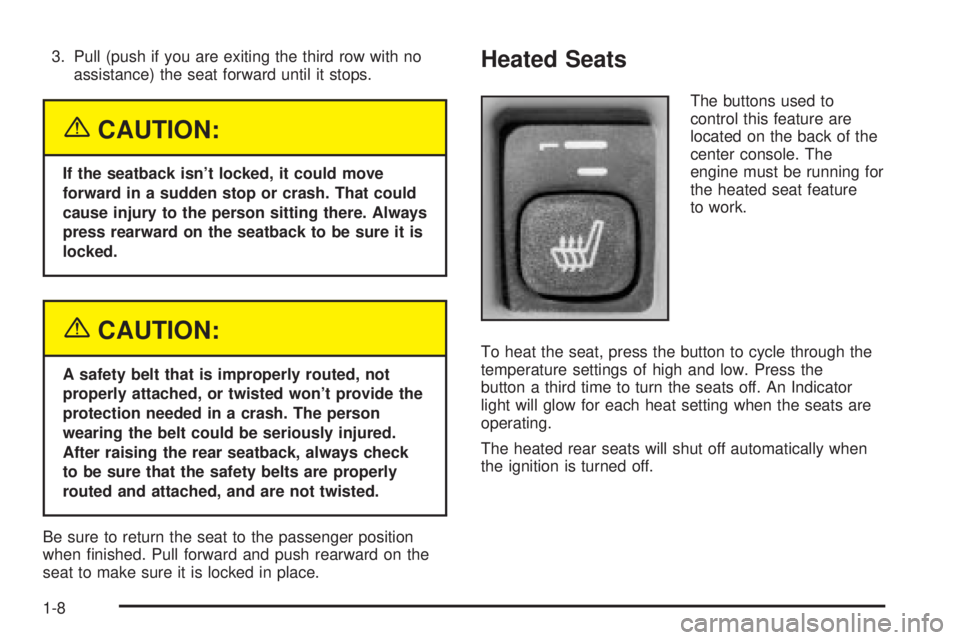
3. Pull (push if you are exiting the third row with no
assistance) the seat forward until it stops.
{CAUTION:
If the seatback isn't locked, it could move
forward in a sudden stop or crash. That could
cause injury to the person sitting there. Always
press rearward on the seatback to be sure it is
locked.
{CAUTION:
A safety belt that is improperly routed, not
properly attached, or twisted won't provide the
protection needed in a crash. The person
wearing the belt could be seriously injured.
After raising the rear seatback, always check
to be sure that the safety belts are properly
routed and attached, and are not twisted.
Be sure to return the seat to the passenger position
when ®nished. Pull forward and push rearward on the
seat to make sure it is locked in place.
Heated Seats
The buttons used to
control this feature are
located on the back of the
center console. The
engine must be running for
the heated seat feature
to work.
To heat the seat, press the button to cycle through the
temperature settings of high and low. Press the
button a third time to turn the seats off. An Indicator
light will glow for each heat setting when the seats are
operating.
The heated rear seats will shut off automatically when
the ignition is turned off.
1-8
Page 17 of 468
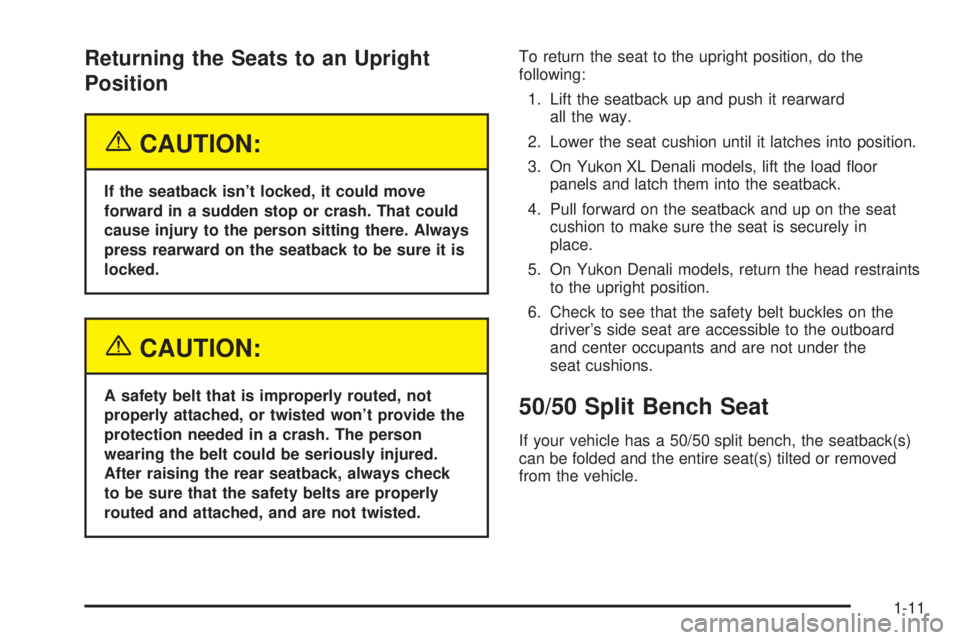
Returning the Seats to an Upright
Position
{CAUTION:
If the seatback isn't locked, it could move
forward in a sudden stop or crash. That could
cause injury to the person sitting there. Always
press rearward on the seatback to be sure it is
locked.
{CAUTION:
A safety belt that is improperly routed, not
properly attached, or twisted won't provide the
protection needed in a crash. The person
wearing the belt could be seriously injured.
After raising the rear seatback, always check
to be sure that the safety belts are properly
routed and attached, and are not twisted.To return the seat to the upright position, do the
following:
1. Lift the seatback up and push it rearward
all the way.
2. Lower the seat cushion until it latches into position.
3. On Yukon XL Denali models, lift the load ¯oor
panels and latch them into the seatback.
4. Pull forward on the seatback and up on the seat
cushion to make sure the seat is securely in
place.
5. On Yukon Denali models, return the head restraints
to the upright position.
6. Check to see that the safety belt buckles on the
driver's side seat are accessible to the outboard
and center occupants and are not under the
seat cushions.50/50 Split Bench Seat
If your vehicle has a 50/50 split bench, the seatback(s)
can be folded and the entire seat(s) tilted or removed
from the vehicle.
1-11
Page 22 of 468
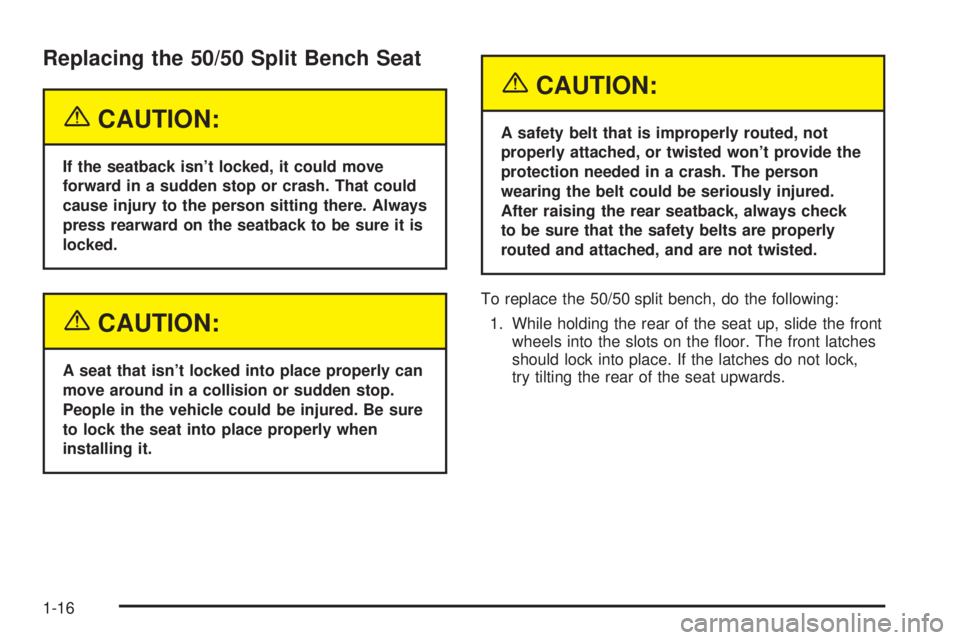
Replacing the 50/50 Split Bench Seat
{CAUTION:
If the seatback isn't locked, it could move
forward in a sudden stop or crash. That could
cause injury to the person sitting there. Always
press rearward on the seatback to be sure it is
locked.
{CAUTION:
A seat that isn't locked into place properly can
move around in a collision or sudden stop.
People in the vehicle could be injured. Be sure
to lock the seat into place properly when
installing it.
{CAUTION:
A safety belt that is improperly routed, not
properly attached, or twisted won't provide the
protection needed in a crash. The person
wearing the belt could be seriously injured.
After raising the rear seatback, always check
to be sure that the safety belts are properly
routed and attached, and are not twisted.
To replace the 50/50 split bench, do the following:
1. While holding the rear of the seat up, slide the front
wheels into the slots on the ¯oor. The front latches
should lock into place. If the latches do not lock,
try tilting the rear of the seat upwards.
1-16
Page 27 of 468
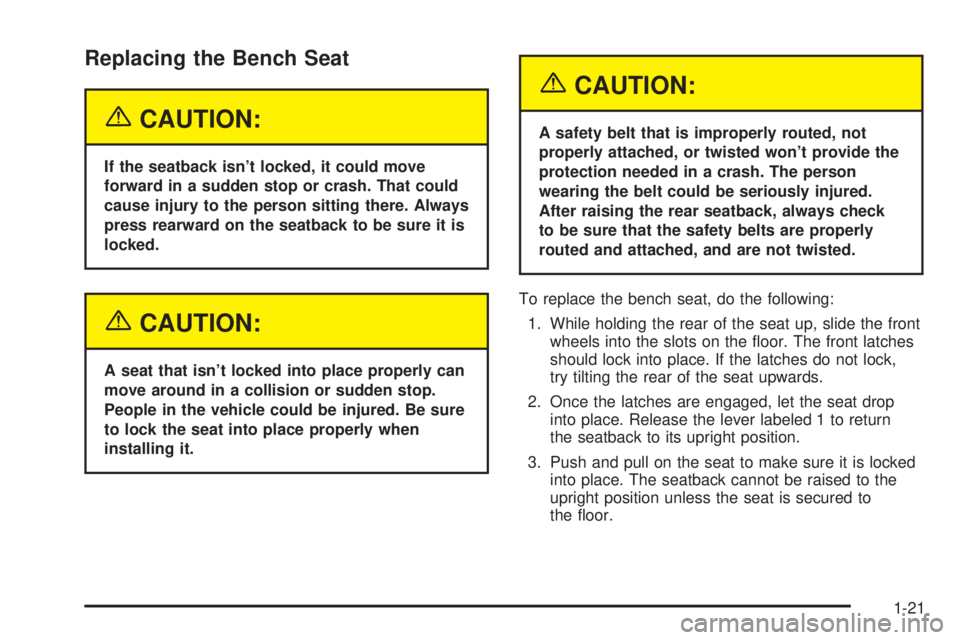
Replacing the Bench Seat
{CAUTION:
If the seatback isn't locked, it could move
forward in a sudden stop or crash. That could
cause injury to the person sitting there. Always
press rearward on the seatback to be sure it is
locked.
{CAUTION:
A seat that isn't locked into place properly can
move around in a collision or sudden stop.
People in the vehicle could be injured. Be sure
to lock the seat into place properly when
installing it.
{CAUTION:
A safety belt that is improperly routed, not
properly attached, or twisted won't provide the
protection needed in a crash. The person
wearing the belt could be seriously injured.
After raising the rear seatback, always check
to be sure that the safety belts are properly
routed and attached, and are not twisted.
To replace the bench seat, do the following:
1. While holding the rear of the seat up, slide the front
wheels into the slots on the ¯oor. The front latches
should lock into place. If the latches do not lock,
try tilting the rear of the seat upwards.
2. Once the latches are engaged, let the seat drop
into place. Release the lever labeled 1 to return
the seatback to its upright position.
3. Push and pull on the seat to make sure it is locked
into place. The seatback cannot be raised to the
upright position unless the seat is secured to
the ¯oor.
1-21
Page 31 of 468
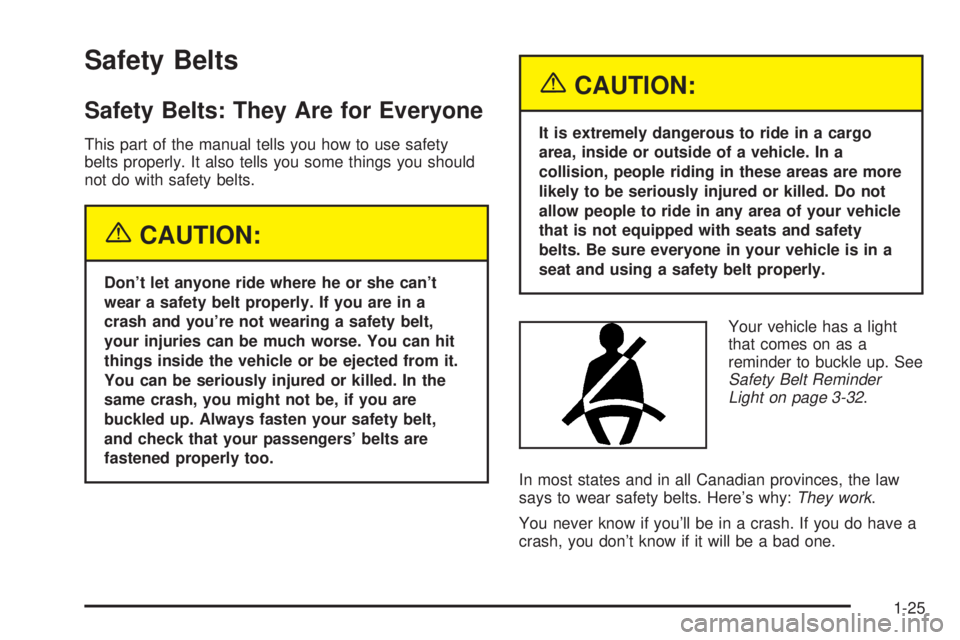
Safety Belts
Safety Belts: They Are for Everyone
This part of the manual tells you how to use safety
belts properly. It also tells you some things you should
not do with safety belts.
{CAUTION:
Don't let anyone ride where he or she can't
wear a safety belt properly. If you are in a
crash and you're not wearing a safety belt,
your injuries can be much worse. You can hit
things inside the vehicle or be ejected from it.
You can be seriously injured or killed. In the
same crash, you might not be, if you are
buckled up. Always fasten your safety belt,
and check that your passengers' belts are
fastened properly too.
{CAUTION:
It is extremely dangerous to ride in a cargo
area, inside or outside of a vehicle. In a
collision, people riding in these areas are more
likely to be seriously injured or killed. Do not
allow people to ride in any area of your vehicle
that is not equipped with seats and safety
belts. Be sure everyone in your vehicle is in a
seat and using a safety belt properly.
Your vehicle has a light
that comes on as a
reminder to buckle up. See
Safety Belt Reminder
Light on page 3-32.
In most states and in all Canadian provinces, the law
says to wear safety belts. Here's why:
They work.
You never know if you'll be in a crash. If you do have a
crash, you don't know if it will be a bad one.
1-25
Page 32 of 468
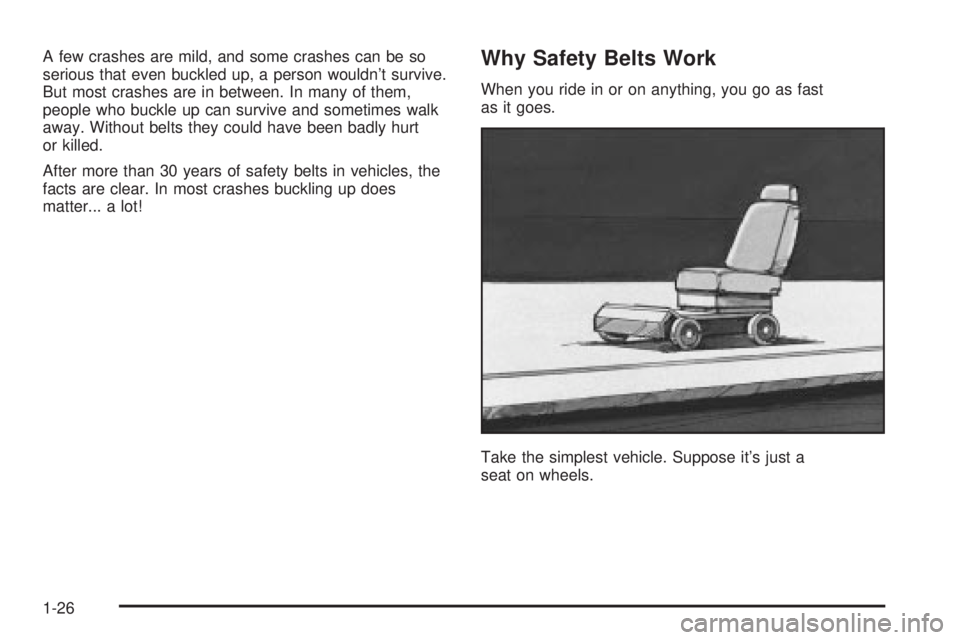
A few crashes are mild, and some crashes can be so
serious that even buckled up, a person wouldn't survive.
But most crashes are in between. In many of them,
people who buckle up can survive and sometimes walk
away. Without belts they could have been badly hurt
or killed.
After more than 30 years of safety belts in vehicles, the
facts are clear. In most crashes buckling up does
matter... a lot!Why Safety Belts Work
When you ride in or on anything, you go as fast
as it goes.
Take the simplest vehicle. Suppose it's just a
seat on wheels.
1-26
Page 35 of 468
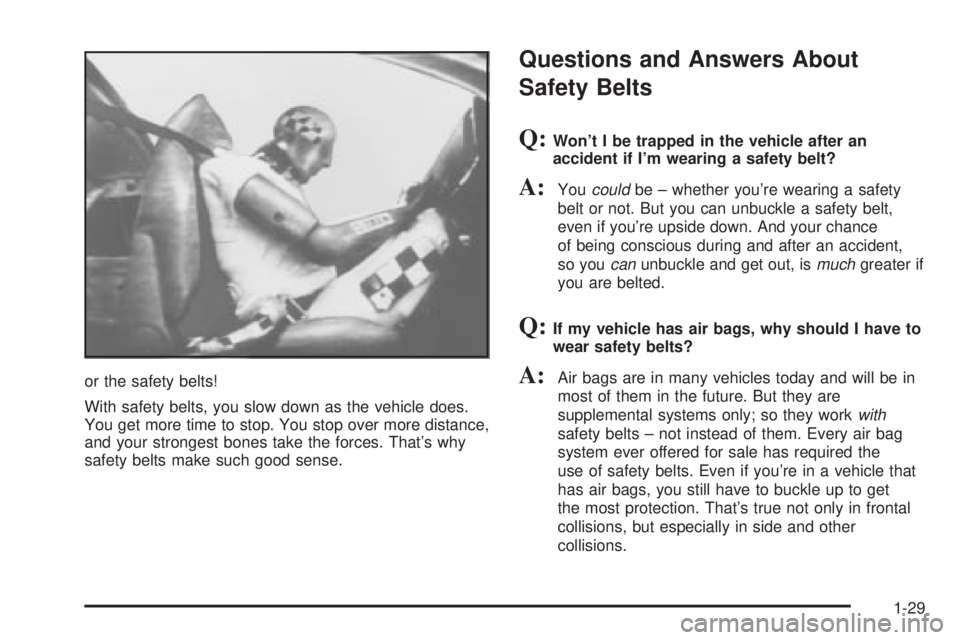
or the safety belts!
With safety belts, you slow down as the vehicle does.
You get more time to stop. You stop over more distance,
and your strongest bones take the forces. That's why
safety belts make such good sense.
Questions and Answers About
Safety Belts
Q:Won't I be trapped in the vehicle after an
accident if I'm wearing a safety belt?
A:Youcouldbe ± whether you're wearing a safety
belt or not. But you can unbuckle a safety belt,
even if you're upside down. And your chance
of being conscious during and after an accident,
so you
canunbuckle and get out, ismuchgreater if
you are belted.
Q:If my vehicle has air bags, why should I have to
wear safety belts?
A:Air bags are in many vehicles today and will be in
most of them in the future. But they are
supplemental systems only; so they work
with
safety belts ± not instead of them. Every air bag
system ever offered for sale has required the
use of safety belts. Even if you're in a vehicle that
has air bags, you still have to buckle up to get
the most protection. That's true not only in frontal
collisions, but especially in side and other
collisions.
1-29